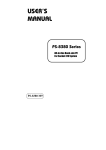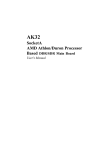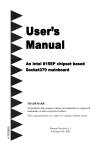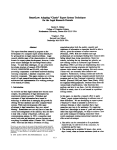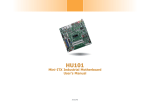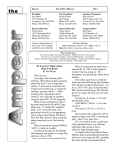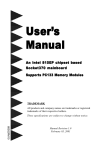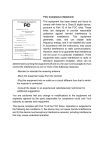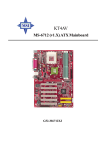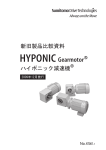Download Based MAIN BOARD
Transcript
AE23 FC-PGA/PPGA Celeron and FC-PGA Pentium III Processor Based MAIN BOARD User's Manual Shuttle® SpacewalkerTM AE23 PPGA/FC-PGA Celeron and FC-PGA Pentium III processor based AGPset Mainboard Manual Version 1.0 Copyright Copyright© 2001 by Shuttle® Inc. All Rights Reserved. No part of this publication may be reproduced, transcribed, stored in a retrieval system, translated into any language, or transmitted in any form or by any means, electronic, mechanical, magnetic, optical, chemical, photocopying, manual, or otherwise, without prior written permission from Shuttle® Inc. Disclaimer Shuttle® Inc. shall not be liable for any incidental or consequential damages resulting from the performance or use of this product. This company makes no representations or warranties regarding the contents of this manual. Information in this manual has been carefully checked for reliability; however, no guarantee is given as to the correctness of the contents. In the interest of continued product improvement, this company reserves the right to revise the manual or include changes in the specifications of the product described within it at any time without notice and without obligation to notify any person of such revision or changes. The information contained in this manual is provided for general use by the customers. Trademarks Spacewalker is a registered trademark of Shuttle Inc. Intel, Pentium is a registered trademarks of Intel Corporation. PS/2 is a registered trademark of IBM Corporation. AWARD is a registered trademark of Award Software Inc. Microsoft and Windows are registered trademarks of Microsoft Corporation. General Notice: Other brand and product names used herein are for identification purposes only and may be trademarks of their respective owners. M406 TABLE OF CONTENTS WHAT’S IN THE MANUAL ..................................................................... 5 Quick Reference ................................................................................................ 5 About This Manual ............................................................................................ 5 1 INTRODUCTION ................................................................................. 6 1.1 TO DIFFERENT USERS .............................................................................. 6 FIRST-TIME DIY SYSTEM BUILDER ............................................................ 6 EXPERIENCED DIY USER ......................................................................... 6 SYSTEM INTEGRATOR ............................................................................... 6 1.2 ITEM CHECKLIST: ....................................................................................... 7 2 FEATURES .......................................................................................... 8 2.1 SPECIFICATIONS ........................................................................................ 8 3 HARDWARE INSTALLATION ........................................................... 11 3.1 STEP BY STEP INSTALLATION ................................................................ 11 Accessories of AE23 ............................................................................. 11 STEP 1 Install the CPU ........................................................................... 12 STEP 2 Set Jumpers .............................................................................. 13 STEP 3 Install SDRAM System Memory ................................................. 13 STEP 4 Install Peripherals in System Case............................................. 14 STEP 5 Mount the Mainboard on the Computer Chassis ........................ 15 STEP 6 Connect Front Panel Switches/LEDs/Speaker/USB .................. 16 STEP 7 Connect IDE & Floppy Disk Drives ............................................ 19 STEP 8 Connect Other Internal Peripherals ............................................ 20 STEP 9 Connect the Power Supply ........................................................ 20 STEP 10 Install Add-on Cards in Expansion Slots .................................. 21 STEP 11 Connect External Peripherals to Back Panel ........................... 22 STEP 12 First Time System Boot Up ...................................................... 24 -1- STEP 13 Install Drivers & Software Components .................................... 25 3.2 JUMPER SETTINGS .................................................................................. 26 JUMPERS & CONNECTORS GUIDE .................................................... 27 Jumpers Clear PS/2 Keyboard Power on Password (J7) ..................................... 30 Clear CMOS Setting (J2) ....................................................................... 30 FSB Speed Auto Configure Setting (J1,JP3,JP5) ...................................31 Firmware Hub Block Lock (J5)................................................................ 32 PS/2 KB & MS Power-on Setting (J18)................................................... 32 Back-Panel Connectors PS/2 Keyboard & PS/2 Mouse Connectors ............................................ 33 USB1/USB2 Port Connectors .................................................................33 COM1/2 Connector ................................................................................ 33 Parallel Port Connector...........................................................................33 Line-Out ................................................................................................. 34 Line-In .................................................................................................... 34 Mic-In ..................................................................................................... 34 MIDI/GAME Port .....................................................................................34 Front-Panel Connectors HDD LED Connector (HDD LED) ........................................................... 35 Hardware Reset Connector (RST BTN) .................................................. 35 Green LED Connector (GEN LED) ......................................................... 35 ATX Power On/Off Switch Connector (PWN BTN) ...................................36 Power LED Connector (POWER LED) ................................................... 36 Keylock Connector (KEYLOCK) ............................................................. 36 Speaker Connector (SPKER) .................................................................37 System Management Interface Connector (SMI BTN).............................. 37 -2- Internal Peripherals Connectors Enhanced IDE Connector and Floppy Connector .................................... 38 Other Connectors ATX Power Supply Connector (JWR1) .................................................... 39 Cooling Fan Connectors for CPU (FAN1) and System or Chassis (FAN2) (FAN3) ......................................................... 39 Wake-on Modem Connector (JP10) ........................................................ 40 Audio Telephone_IN Header (JP11) ........................................................ 40 Audio Auxiliary_IN Header (JP12) .......................................................... 40 Audio CD_IN Header (JP13) .................................................................. 41 Wake on Lan Header (J13) ..................................................................... 41 Dual USB Connectors Header (J6) ......................................................... 41 IR Header (J17) ...................................................................................... 42 3.3 SYSTEM MEMORY CONFIGURATION ...................................................... 43 1. INSTALL MEMORY ............................................................................. 43 2. UPGRADE MEMORY ......................................................................... 43 4 SOFTWARE UTILITY .......................................................................44 4.1 Mainboard CD Overview .......................................................................... 44 4.2 Install Mainboard Software ...................................................................... 45 4.2.A Install Chipset System Driver ............................................................ 46 4.2.B Install AC97 Audio Driver .................................................................. 47 4.2.C Install Synthesizer ............................................................................. 48 4.3 Install IDE Driver ....................................................................................... 49 4.4 View the User's Manual ............................................................................ 50 5 BIOS SETUP .....................................................................................51 5.1 ENTER BIOS .............................................................................................. 51 -3- 5.2 THE MAIN MENU ....................................................................................... 52 STANDARD CMOS FEATURES ................................................................ 54 ADVANCED BIOS FEATURES .................................................................. 58 ADVANCED CHIPSET FEATURES ........................................................... 62 INTEGRATED PERIPHERALS ................................................................... 65 POWER MANAGEMENT SETUP .............................................................. 70 PNP/PCI CONFIGURATION ....................................................................... 74 PC HEALTH STATUS ................................................................................. 76 FREQUENCY/VOLTAGE CONTROL .......................................................... 78 LOAD FAIL-SAFE DEFAULTS ................................................................... 79 LOAD OPTIMIZED DEFAULTS .................................................................. 79 SET SUPERVISOR PASSWORD .............................................................. 80 SET USER PASSWORD ...........................................................................80 SAVE & EXIT SETUP................................................................................. 82 EXIT WITHOUT SAVING ............................................................................. 82 -4- WHAT’S IN THE MANUAL Quick Reference Hardware Installation >> Step-by-Step ................................................ Page 12 Jumper Settings >> A Closer Look ...................................................... Page 26 Drivers/Software Utilities >> How to Install ......................................... Page 44 BIOS Setup >> How to Configure ........................................................ Page 51 About This Manual For First-Time DIY System Builder ......................................................... Page 6 For Experienced DIY User ...................................................................... Page 6 For System Integrator ............................................................................. Page 6 -5- 1 INTRODUCTION 1.1 To Different Users First-Time DIY System Builder Welcome to the DIY world! Building your own computer system is not as difficult as you may think. To make your first computer DIY experience successful, right from the start, we have designed the 3.1 Hardware Installation section in a step-by-step fashion for all the first-time DIY system builders. Prior to installation, we also suggest you to read the whole manual carefully to gain a complete understanding of your new Shuttle AE23 mainboard. Experienced DIY User Congratulate on your purchase of the Shuttle AE23 mainboard. You will find that installing your new Shuttle AE23 mainboard is just easy. Bundled with an array of onboard functions, the highly-integrated AE23 mainboard provides you with a total solution to build the most stable and reliable system. Refer to sections 3.2 Jumper Settings and Chapter 4 Drivers/Software Utilities to find out how to get the best out of your new mainboard. Chapter 5 BIOS Setup also contains the relevant information on how to tune up your system to achieve higher performance. System Integrator You have wisely chosen Shuttle AE23 to construct your system. Shuttle AE23 incorporates all the state-of-the-art technology of the AE23 chipset from Intel. It integrates the most advanced functions you can find to date in a compact ATX board. Refer to sections 3.2 Jumper Settings and Chapter 4 Drivers/ Software Utilities for an in-depth view of system construction. -6- 1.2 Item Checklist: Check all items with you AE23 mainboard to make sure nothing is missing. The complete package should include: IR J1 7 J7 1 KB M S1 USB1 JP8 AJ 1 1 JP 11 ! One Shuttle AE23 Mainboard 1 J1 8 JP 12 J1 3 1 FA1 N 1 RichT ekRT92 1 CS13 M91 H GS4 D8 752 32D 1 1 FA3 N HS4 8 GD752 32D 1 JP 13 1 JW R1 n i bond W8362 HF- A W cAM7 .M E GA. 8 79 -6 1 JP 10 CNR 1 SL1 DIM M 1 DIM M 2 P anas on ic C R2 032 3V JAPAN 1 DIM M 3 1 FP L1 14 .3 C93 1 FW9 82 8Q 1 0A B L9 4E 0 4 3 9 N IQTE L89 ‘S c M GA 4Y9 0 S4 2E N M L9 1 1 JP 5JP 3 int el IDE2 1 J1 IDE1 C A5657 A ES 9952 9250 AF- 0 3 -7- 1 ! One Shuttle Spacewalker Bundled CD-ROM containing: " AE23 user’s manual saved in PDF format " Intel Chipset System Driver " AC97 audio CODEC driver " Synthesizer " IDE driver " Award Flashing Utility 1 ! One AE23 User’s Manual 1 ! One two ports USB Cable (optional) J2 ! One Floppy Ribbon Cable 1-24 3- 1 J6 1 1 ! One ATA 100/66/33 Ribbon Cable FA2 N J5 SP KR E RS T HD D GE N SM I BT PW N BT N LE D LE D BT N N USB 3 &4 J1 1 PO W R KE Y LEE D LO CK 2 FEATURES AE23 mainboard is carefully designed for the demanding PC user who wants high performance and maximum intelligent features in a compact package. 2.1 Specifications CPU Support Intel FC-PGA/PPGA Celeron processors with 66MHZ FSB. Intel FC-PGA Pentium III processors with 100/133MHZ FSB. Chipset Features Intel 815EP N.B. and Intel 82801BA S.B.. Jumperless CPU Configuration Soft-configuration FSB (The FSB speed is software configurable from 66MHz to 166MHz in the Frequency/Voltage Control of BIOS setup program.) AC'97 Link for Audio and Telephony CODEC AC'97 2.1compliant Independent bus master logic for 5 channels Separate independent PCI functions for Audio and Modem Versatile Memory Support Is equipped with three DIMM slots for (16, 32, 64, 128, 256, or 512 MB) 168-pin 100MHz or 133MHZ PC SDRAM. The total memory is up to 512 MB. PCI Expansion Slots Provides six 32-bit PCI slots. AGP Expansion Slots Provides one 32-bit AGP slot which supports up to 4X AGP devices. CNR Expansion Slots Provides one CNR (Communication/Network Riser) slot. -8- 4 USB Ports Onboard Ø 2 × USB connectors on back-panel and dual USB connectors header on front panel. Onboard I/O Ports and Interfaces Provides a variety of I/O interfaces: Ø 1× Floppy interface for 3.5-inch FDD with 720KB, 1.44MB, 2.88MB format or for 5.25-inch FDD with 360KB or 1.2MB format. Ø 1 × PS/2 mouse header Ø 1 × PS/2 Keyboard header Ø 2 × DB9 Serial connectors 16V550 UART compatible Ø 1× DB25 Parallel port supports Standard Parallel Port and Bi-direc tional (SPP), Enhanced Parallel Port (EPP), and Extended Capabilities Port (ECP) data transmission schemes. PCI Bus Master IDE Controller Onboard Two Ultra DMA 100/66/33 Bus Master Dual-channel IDE ports provide support to a maximum of four IDE devices (one Master and one Slave per channel). The IDE Bus implements data transfer speeds of up to 100/66/33 MB/sec and also supports Enhanced PIO Modes 0~4. 80-pin Cable Backward Compatible Legacy ATAPI Devices, ATAPI IDE CDROM, CD-R, CD-RW, and LS-120 Supports. ATX Power Supply Connector ATX power supply unit can connect to the onboard 20-pin ATX power connector, supporting Suspend and Soft-On/Off by dual-function power button. Advanced Configuration and Power Interface Features four power saving modes: S1(Snoop), S3 (Suspend to RAM), and S5 (Soft-Off). ACPI provides more efficient Energy Saving Features controlled by your operating system that supports OS Direct Power Management (OSPM) functionality. System BIOS Provides licensed Award BIOS V6.0 PG on Intel Firmware Hub 4Mb Flash core and supports Green PC, Desktop Management Interface (DMI). -9- ATX Form Factor System board conforms to ATX specification. Board dimension: 304mm × 215mm. Advanced Features Ø Low EMI - Built in spread spectrum and automatic clock shut-off of unused PCI/SDRAMS slots to reduce EMI. Ø PS/2 Keyboard / PS/2 Mouse Power-On - This mainboard implements a special jumper to enable a system power-on function by PS/2 keyboard or PS/2 mouse. Ø Dual Function Power Button - The system can be in one of two states, one is Suspend mode and the other is Soft-Off mode. Pushing the power button for less than 4 seconds places the system into Suspend mode. When the power button is pressed for longer than 4 seconds, the system enters Soft-Off mode. Ø Wake-on-LAN (WOL) - The onboard WOL connector can be attached to a network card that supports this function to wake up system via LAN. Ø Modem Ring Power-On - The system can be powered on automatically by the activation of modem ringing. Intelligent Features Ø CPU Host Clock Setting - This item allows users to adjust CPU Host Clock in BIOS. Ø Voltage Monitoring - Monitors various voltages of key elements, such as the CPU, and other critical system voltage levels to ensure stable current passing through mainboard components. System voltages include Vcore/ VTT on CPU, and +5V, +12V, -5V, -12V on system etc. Ø Fan Status Monitoring - To prevent CPU from overheating, the CPU fan is monitored for RPM and failure. (CPU Cooling FAN with RPM sensor is required.) Ø Temperature Monitoring - This item allows users to make sure whether the CPU or system runs in a suitable temperature. - 10 - 3 HARDWARE INSTALLATION Before removing or installing any of these devices including CPU, DIMMs, Add-On Cards, Cables, please make sure to unplug the onboard power connector. This section outlines how to install and configure your mainboard. Refer to the following mainboard layout to help you to identify various jumpers, connectors, slots, and ports. Then follow these steps designed to guide you through a quick and correct installation of your system. 3.1 Step-by-Step Installation Accessories Of AE23 FAN2 1 1 JP5 JP3 J1 USB1 JP 8 C A5657A ES 9952 9250AF- 30 14. 3C93 RichTek RT9231 CS1M9 1 Parallel Connector FAN1 FAN1 IDE2 HS48 GD 75 232D Two E-IDE Connectors Floppy Connector INTEL 82801BA Chipset 1 SOCKET 370 IDE1 FLP1 AJ 1 Line-In/Line-Out/Mic-In Game/MIDI Connectors HS48 GD 75 232D 1 DIM M1 DIM M2 1 1 DIM M3 SL1 On Board Audio CODEC JP10 1 c AM. MEGA. 87 -96 inbond Wake-on Modem - JP10 I/O Controller W8 36 2 7H F- AW Serial Port Connector (COM2) INTEL 82815EP Chipset FSB Auto Config - J1, JP3, JP5 1 1 J18 1 JWR1 Serial Port Connector (COM1) KB MS1 1-2 3-4 PS/2 KB & MS PowerOn Setting - J18 PS/2 Keyboard and PS/2 Mouse Connectors ATX Power Connector Two USB Connectors FAN2 Three DIMM Slots J7 1 1 c FW 82801BA L949004Q Q938E S I N TE L 99 JP12 1 FAN3 J A PA N1 P a n a s o n ic CR 2032 3V M JP13 intel Onboard Audio Connectors- JP11/JP12 /JP13 J2 1 J5 1 1 FAN3 IR Connector - J17 USB_ 3&4 J17 J13 J6 1 1 J11 CN R 1 One CNR Slot One AGP 2x/4x Slot - 11 - Two Ports USB Header - J6 Front Panel Connector - J11 RST B TN P O WE R L ED HDD L ED K EY L OC K Six PCI Slots GEN L ED S MI B TN S PK E R Wake-on LAN - J13 P WN B TN IR 1 Clear CMOS - J2 Programmable Flash EEPROM (FWH) FWH Block Lock - J5 JP11 G94S9024N E MALAY Clear PS/2 Keyboard Power On Password - J7 Step 1 Install the CPU: 1. Locate the CPU ZIF (Zero Insertion Force) socket on the upper-right sector of your mainboard (between the back-panel connectors and the DIMM memory slots). 2. Pull the CPU ZIF socket lever slightly sideways away from the socket to unlock the lever, and then bring it to an upward vertical position. 3. Place your PPGA / FC-PGA 370 processor in the ZIF socket. Note that the CPUs edges have been purposely designed non-symmetrical to prevent from inserting the processor in wrong direction. The following diagram demonstrates the correct placement of CPU in the ZIF socket. You can see that the two blunt-edged corners should face towards the socket-lever. P PG A CP U FC-P G A CP U R ‘ 99 2/)!% m c 2/)!% 2/)!% I Pent ium ® MALAY RB8 0526 PY550 256 Q9 44A 036 -039 3 SL3R3 B lan k Leve r B lan k Notch Notch 4. Slightly push CPU into socket without applying excessive force while making sure there is no gap between CPU and socket. Then lower the socket lever all the way down to the horizontal position and lock it to secure the CPU in place. 5. The PPGA / FC-PGA 370 CPU requires a set of heatsink/fan to ensure proper cooling of processor. If heatsink/fan are not already mounted on your CPU, you must purchase them separately and have it installed. Plug the cable from heatsink/fan to CPU fan power connector located nearby. Note that there are several types of CPU fan connectors. Normally, if your mainboard supports hardware monitoring function, a 3-pin fan power connector should allow your system to detect the CPU fans speed . The CPU fan can also run with a 2-pin fan power connector, however, detection of CPU fans speed is not supported. Another type of CPU fan may feature a large 4-pin fan power connector, which does not support CPU fan's speed detection and must connect directly to the system power supply unit. - 12 - Step 2. Set Jumpers This mainboard is jumperless! The default jumper settings have been set for the common usage standard of this mainboard. Therefore, you do not need to reset the jumpers unless you require special adjustments as any of the following cases: 1. 2. 3. 4. Overclock your CPU Clear CMOS Clear system password Clear the password to power on system by PS/2 keyboard For first-time DIY system builders, we recommend that you do not change the default jumper settings if you are not totally familiar with the mainboard configuration procedures. The factory-set default settings are tuned for optimum system performance. For the advanced users who wish to customize their system, section 3.2 Jumper Settings will provide detailed information on how to configure your mainboard manually. Step 3 Install SDRAM System Memory To install memory, insert SDRAM memory module(s) in any one or two or three DIMM banks. Note that SDRAM modules are directional and will not go in the DIMM slots if they are not properly oriented. After the module is fully inserted into the DIMM slot, lift the clips of both sides of the DIMM bank to lock the module in place. - 13 - Step 4 Install Internal Peripherals in System Case Before you install and connect the mainboard into your system case, we recommend that you first assemble all the internal peripheral devices into the computer housing, including but not limited to the hard disk drive (IDE/ HDD), floppy disk drive (FDD), CD-ROM drive, and ATX power supply unit. This will greatly facilitate in making the connections to the mainboard described below. To install IDE & FDD drives, follow this procedure: 1. Set the required jumpers on each device according to the instructions provided by the manufacturer. (IDE devices, HDD, and CD-ROM, have to set jumpers to Master or Slave mode depending on whether you install more than one device of each kind.) 2. Connect IDE cable and FDD cable on the back-panel of the internal peripheral devices to the corresponding headers on board. Note that the cable should be oriented with its colored stripe (usually red or magenta) connected to pin#1 both on the mainboard IDE or FDD connector and on the device as well. 3. Connect an available power cable from your system power supply unit to the back-panel of each peripheral device. Note that the power cable is directional and cannot fit in if not properly positioned. - 14 - Step 5 Mount the Mainboard on the Computer Chassis 1. You may find that there are a lot of different mounting hole positions both on your computer chassis and on the mainboard. To choose correct mounting holes, the key point is to keep the back-panel of the mainboard in a close fit with your system case, as shown below. 2. After deciding on the proper mounting holes, position the studs between the frame of the chassis and the mainboard. The studs are used to fix the mainboard and to keep a certain distance between the system chassis and the mainboard, in order to avoid any electrical shorts between the board and the metal frame of the chassis. (If your computer case is already equipped with mounting studs, you will need to tighten screws to attach the mainboard.) Note: In most computer housings, you will be able to find 4 or more attachment points to install mounting studs and then fix the mainboard. If there arent enough matching holes, then make sure to install at least 4 mounting studs to ensure proper attachment of the mainboard. - 15 - Step 6 SMI B TN S PK ER PWN B TN Connect Front Panel Switches/LEDs/Speaker/USB You can find there are several different cables already existing in the system case and originating from the computers front-panel devices (HDD LED, Power LED, Reset Switch, PC Speaker, or USB devices etc.) These cables serve to connect the front-panel switches, LEDs, and USB connectors to the mainboards front-panel connectors group, as shown below. HDD LE D K EY LO C K G EN LE D U S B _3& 4 1 J11 R ST B TN P OW E R LE D J6 1 J11 P WN B TN S MI B TN + G EN LE D + HDD LE D RS T B TN P OW E R LE D + - K EY LO C K S PK E R 1. Hardware Reset Switch Button (RST BTN) 1 J11 - 16 - P WN B TN S MI B TN + G EN LE D + HDD LE D RS T B TN P OW E R LE D + - K EY LO C K S PK E R 2. HDD-LED (HDD LED) 1 J11 - 17 - P WN B TN J11 S MI B TN 6. Power LED (POWER LED) RS T B TN P OW E R LE D + - + HDD LE D + G EN LE D K EY LO C K S MI B TN P WN B TN S PK E R J11 + G EN LE D S PK E R 5. ATX Soft Power On/Off (PWN BTN) + HDD LE D K EY LO C K RS T B TN P OW E R LE D + - + HDD LE D + G EN LE D K EY LO C K S MI B TN P WN B TN S PK E R 4. System Management Interface Button (SMI BTN) J11 RS T B TN P OW E R LE D + - RS T B TN P OW E R LE D + - + HDD LE D + G EN LE D K EY LO C K S MI B TN P WN B TN S PK E R 3. Green-LED (GEN LED) 1 1 1 1 RS T B TN P OW E R LE D + - + HDD LE D K EY LO C K + G EN LE D S MI B TN S PK E R P WN B TN 7. Keylock (KEY LOCK) 1 J11 RS T B TN P OW E R LE D + - + HDD LE D K EY LO C K + G EN LE D S MI B TN S PK E R P WN B TN 8. PC Speaker (SPKER) 1 J11 9. Front-panel USB connectors header USB_3&4 +5V GR OUN D U SBD2 - GR OUN D U SBD2 + U SBD3 + GR OUN D U SBD3 - GR OUN D +5V 1 - 18 - Step 7 Connect IDE & Floppy Disk Drives 1. IDE cable connector IDE 1 IDE 2 1 1 2. Floppy cable connector FLP1 1 - 19 - Step 8 Connect Other Internal Peripherals 1. Telephone_IN, Auxiliary_IN, CD_IN connectors JP11 JP13 1 1 JP12 1 2. IR connector IR J17 Step 9 J W R1 Connect the Power Supply 1. System power connector - 20 - Step 10 Install Add-on Cards in Expansion Slots 1. Accelerated Graphics Port (AGP) Card 2. PCI Card 3. CNR (Communication/Network Riser) Card The CNR Slot supports the audio, modem, lan, Home PNA of Intel 82801BA chipset. Note: The CNR Card is optional at the time of purchase. - 21 - Step 11 Connect External Peripherals to Back-Panel You are now ready to put the computer case back together and get on to the external peripherals connections to your systems back-panel. KB MS1 USB1 JP 8 AJ 1 1. PS/2 Mouse and PS/2 Keyboard PS/2 Mouse PS/2 keyboard 2. USB Devices USB1 & USB2 3. COM Port COM1 COM2 - 22 - 4. Parallel Port Parallel Port 5. MIDI/GAME Port MIDI/GAME Port 6. Audio Line_Out / Line_In / Mic_In Line-Out - 23 - Line-In Mic-In Step 12 First Time System Boot Up To assure the completeness and correctness of your system installation, you may check the above installation steps once again before you boot up your system for the first time. 1. Insert a bootable system floppy disk (DOS 6.2x, Windows 95/98/NT, or others) which contains FDISK and FORMAT utilities into the FDD. 2. Turn on the system power. 3. First, you must use the FDISK utility to create a primary partition of the hard disk. You can also add an extended partition if your primary partition does not use all of the available hard disk space. If you choose to add an extended partition, you will have to create one or more logical partitions to occupy all the space available to the extended partition. The FDISK utility will assign a drive letter (i.e., C:, D:, E:,...) to each partition which will be shown in the FDISK program. After FDISK procedure, reboot your system by using the same system floppy disk. Note: DOS 6.2x and Windows 95A can only support up to 2.1GB of HDD partition. If you use the FDISK utility with one of the operating systems mentioned above, you can only install your HDD into partitions no larger than 2.1GB each. 4. Now, use the FORMAT utility to format all the partitions youve created. When formatting the primary partition (C:), make sure to use the FORMAT C: /S command. Note: FORMAT C: /S can transfer all the necessary system files into the primary partition of your hard disk. Then, your HDD will become a bootable drive. 5. Install all the necessary drivers for CD-ROM, Mouse, etc. 6. Setup the complete operating system according to your OS installation guide. - 24 - Step 13 Install Drivers & Software Components Please note that all the system utilities and drivers are designed for Win 9x operating systems only. Make sure your Windows 9x operating system is already installed before running the drivers installation CD-ROM programs. 1. Insert the AE23 bundled CD-ROM into your CD-ROM drive. The auto-run program will display the drivers main installation window on screen. 2. Select the "Install Mainboard Software" bar to run into sub-menu. 3. Choose "Install Chipset System Driver" and complete it. 4. Choose "Install AC97 Audio Driver" and complete it. 5. Choose "Install Synthesizer" and complete it. 6. Return to the main installation window and exit from the auto-run drivers installation program. - 25 - 3.2 Jumper Settings Several hardware settings are made through the use of mini jumpers to connect jumper pins on the mainboard. Pin #1 could be located at any corner of each jumper, you just find the location with a white right angle which stands for pin 1#. There are several types of pin 1# shown as below: 3-pin and multi (>3) pin jumpers shown as following: Pin #1to the left: Pin #1 on the top: Pin #1to the right: Pin #1on the bottom: Jumpers with two pins are shown as for Close [On] or for Open [Off]. To Short jumper pins, simply place a plastic mini jumpers over the desired pair of pins. Caution! 1. Do not remove the mainboard from its antistatic protective packaging until you are ready to install it. 2. Carefully hold the mainboard by its edges and avoid touching its components. When putting the mainboard down, place it on top of its original packaging film, on an even surface, and components side up. 3. Wear an antistatic wrist strap or take other suitable measures to prevent electrostatic discharge (ESD) whenever handling this equipment. - 26 - Jumpers & Connectors Guide Use the mainboard layout on page 11 to locate CPU socket, memory banks, expansion slots, jumpers and connectors on the mainboard during the installation. The following list will help you to identify jumpers, slots, and connectors along with their assigned functions: A5 E2 E1 E3 E2 A3 B1 B2 B3~B 4 D1 B5~B 8 A1 E4 A4 E6 A2 E2 E8 C1~C 8 E9 E7 E5 CPU/Memory/Expansion Slots Socket370 : CPU Socket for PPGA/FC-PGA 370 processors DIMM1/2/3 : Three DIMM Slots for 16,32,64,128,256,512MB ,3.3V SDRAM (The total installed memory does not exceed 512MB). AGP : One AGP (Accelerated Graphics Port) Slot PCI : Six 32-bit PCI Expansion Slots CNR : Communication/Network Riser slot - 27 - A1 A2 A3 A4 A5 Jumpers J7 J2 J1/JP3/JP5 J5 J18 : : : : : Clear PS/2 keyboard power on password Clear CMOS setting FSB speed auto configure setting FWH block lock setting PS/2 KB & MS power-on setting Back Panel Connectors B1 KB : PS/2 keyboard B1 MS : PS/2 mouse B2 USB : 2 USB (Universal Serial Bus) ports B3 COM1/2 : Serial port 1(DB9 male) B4 PRINTER : Parallel port (DB25 female) B5 LINE_OUT : LINE_OUT port B6 LINE_IN : LINE_IN port B7 MIC_IN : MIC_IN port B8 GAME/MIDI : GAME/MIDI Port C1 C2 C3 C4 C5 C6 C7 C8 Front Panel Connectors HDD LED : IDE drive active LED (HDD LED) RESET : Hardware reset switch (RST BTN) Green LED : Green LED (GEN LED) Power Switch : ATX power on/off momentary type switch (PWN BTN) Power LED : System power LED (POWER LED) KEYLOCK : KEYLOCK (KEYLOCK) SPEAKER : Internal speaker (SPKER) in housing SMI : System Management Interface (SMI BTN) Internal Peripherals Connectors D1 FLP1 : Floppy disk drive interface D1 IDE1 : IDE primary interface (Dual-channel) D1 IDE2 : IDE secondary interface (Dual-channel) - 28 - E1 E2 E2 E2 E3 E4 E5 E6 E7 E8 E9 Other Connectors JWR1 : ATX power (20-pin header) connector FAN1 : CPU fan connector FAN2 : System & chassis fan connector FAN3 : System & chassis fan connector JP10 : Wake on modem connector JP11 : Telephone_IN connector JP12 : Auxiliary_IN connector JP13 : CD_IN connector J13 : Wake on Lan connector J6 : Dual USB connectors header J17 : IR connector - 29 - F Jumpers A1 Clear PS/2 Keyboard Power on Password (J7) J7 is used to clear PS/2 keyboard power on password. Clearing the J7 will result in erasing the password you set and then any user may power on your system without any secret code. Pin 2-3 (Clear Password) 1 1 J7 Pin 1-2 (Default) 1 Step 1. Turn off the system power (PC-> Off) Step 2. Remove mini jumper from pin 1-2 on J7 Step 3. Place the mini jumper on pin 2-3 of J7 for a few seconds Step 4. Return the mini jumper to pin 1-2 of J7 Step 5. Turn on the system power (PC-> On) A2 Clear CMOS Setting (J2) J2 is used to clear CMOS data. Clearing CMOS will result in the permanently erasing previous system configuration settings and the restoring original (factory-set) system settings. 1 Pin 1-2 (Default) J2 1 1 Pin 2-3 (Clear CMOS) Step 1. Turn off the system power (PC-> Off) Step 2. Remove mini jumpers from pins 1-2 of J2 Step 3. Place the mini jumpers on pin 2-3 of J2 for a few seconds Step 4. Return the mini jumpers to pin 1-2 Step 5. Turn on the system power (PC-> On) - 30 - A3 FSB Speed Auto Configure Setting (J1, JP3, JP5) AE23 provides jumper JP3 and JP5 to set automatically configured. front side bus at 66MHz, 100MHz, 133MHz. Inserting mini jumper on JP3 and JP5 and leave J1all open as below enable users to identify automatically the FSB speed. 1 1 JP5 1 JP 5 JP 3 1-2 3-4 Default JP3 J1 J1 1 1-2 3-4 For experienced users, AE23 mainboard provides an alternative hardware configured function to adjust front side bus manually. Before you adjust FSB frequency by jumper, you need to remove all mini jumpers from JP3 and JP5 and insert mini jumper properly on J1. Manually J1 1 1-2 3-4 System Clock JP3 JP5 J1 (1-2) J1 (3-4) Auto ON ON OFF OFF 66 MHz OFF OFF ON ON 100 MHz OFF OFF ON OFF 133 MHz OFF OFF OFF OFF - 31 - A4 A3 Firmware Hub Block Lock Setting (J5) You may flash BIOS (FWH) by placing mini jumper on Pin1-2. 1 (Default, you may flash BIOS) 1 (Lock the function to flash BIOS) 1 J5 Reflash the BIOS, follow these steps: Step 1. Turn off the system power (PC-> Off). Step 2. Make sure of place jumper cap on J5 pin 1-2. Step 3. Insert a bootable system floppy disk and then turn your system to execute flash utility. A5 PS/2 Keyboard & PS/2 Mouse Power-On Setting (J18) AE23 mainboard provides an easy-to-use function to power on system by PS/2 keyboard and PS/2 mouse. Firstly, you must set J18 jumper to enable power-on function. Then you also need to specify the proper key through BIOS setup program. Please go to field "POWER ON Function" under the sub-menu of "Integrated Peripheral" in BIOS setup program. J18 1 J18 2-3 (default, Enable power-on function) J18 1-2 (Disable power-on function) - 32 - F Back-Panel Connectors B1 PS/2 Keyboard & PS/2 Mouse Connectors Two 6-pin female PS/2 keyboard & Mouse connectors are located at the rear panel of the mainboard. Depending on the computer housing you use (desktop or minitower), the PS/2 Mouse connector is situated at the top of the PS/2 Keyboard connector when the mainboard is laid into a desktop, as opposed to a minitower where the PS/2 Mouse connector is located at the right of the PS/2 Keyboard's. Plug the PS/2 keyboard and mouse jacks into their corresponding connectors. B2 USB1 & USB2 COM1/2 Connector This mainboard can accommodate two serial device on COM1/2. Attach a serial device cable to the DB9 serial port COM1/ 2 at the back panel of your computer. B4 PS/2 keyboard USB1/USB2 Port Connectors This mainboard offers 2 USB ports on front panel. Plug each USB device jack into an available USB1/USB2 connector. B3 PS/2 Mouse COM1 COM2 Parallel Port Connector One DB25 female parallel connector is located at the rear panel of the mainboard. Plug the connection cable from your parallel device (printer, scanner, etc.) into this connector. - 33 - Parallel Port B5 Line-Out Line-Out is a stereo output port through which the combined signal of all internal and external audio sources on the board is output. It can be connected to 1/8-inch TRS stereo headphones or to amplified speakers B6 Line-Out Line-In Line-In is a stereo line-level input port that accepts a 1/8-inch TRS stereo plug. It can be used as a source for digital sound recording, a source to be mixed with the output, or both. Line-In B7 Mic-In Mic-In is a 1/8-inch jack that provides a mono input. It can use a dynamic mono or stereo microphone with a resistance of not more than 600 Ohms. Mic-in B8 MIDI/GAME Port The MIDI/GAME port is a 15-pin female connector. This port can be connected to any IBM PC compatible game with a 15-pin Dsub connector. MIDI/GAME Port MIDI Instrument Connection You will need a MIDI adapter to connect a MIDI compatible instrument to the sound card. The MIDI adapter can in turn be connected to the Joystick/MIDI port. You will also need the MIDI sequencing software to run MIDI instruments with your computer etc. into this connector. - 34 - Front-Panel Connectors G EN LED SM I BT N SPKE R J11 H DD LED 1 J11 SM I BT N G EN LED 1 Note : Please notice all the LED connectors are directional. If your chassiss LED does not light up during running, please simply change to the opposite direction. - 35 - G EN LED SM I BT N SPKE R J11 H DD LED R ST BT N The Green LED (GEN LED) indicates that the system is currently in one of the power saving mode (Doze/Standby/ Suspend). When the system resumes to normal operation mode, the Green LED will go off. Attach a 2-pin Green LED cable to GEN LED header. PW N BT N Green LED Connector (GEN LED ) KEY LO C K C3 R ST BT N PO W ER LED H DD LED KEY LO C K Attach the 2-pin hardware reset switch cable to the RST header. Pressing the reset switch causes the system to restart. PW N BT N Hardware Reset Connector (RST BTN) SPKE R C2 R ST BT N PO W ER LED Attach the connector cable from the IDE device LED to the 2-pin HDD LED header. The HDD LED lights up whenever an IDE device is active. PW N BT N HDD LED Connector (HDD LED) KEY LO C K C1 PO W ER LED F 1 G EN LED SM I BT N SPKE R J11 H DD LED 1 G EN LED SM I BT N SPKE R J11 H DD LED 1 G EN LED SM I BT N SPKE R H DD LED KEY LO C K Attach the 2-pin KEYLOCK connector cable from the housing front panel to the KEYLOCK header on the mainboard. PW N BT N Keylock Connector (KEYLOCK) J11 - 36 - R ST BT N PO W ER LED C6 R ST BT N PO W ER LED Attach the 3-pin Power LED connector cable from the housing front panel to the POWER LED header on the mainboard. The power LED stays light while the system is running. PW N BT N Power LED Connector (POWER LED) KEY LO C K C5 R ST BT N PO W ER LED The Power On/Off Switch is a momentary type switch used for turning on or off the system ATX power supply. Attach the connector cable from the Power Switch to the 2-pin POW BTN header on the mainboard. PW N BT N ATX Power On/Off Switch Connector (PWN BTN) KEY LO C K C4 1 J11 SM I BT N G EN LED 1 G EN LED SM I BT N SPKE R H DD LED KEY LO C K Hardware System Management Interface (SMI) header may attach to 2-pin momentary switch. Press the switch to force system into power saving mode; press it again to resume back the normal operation situation. PW N BT N System Management Interface Connector (SMI BTN) J11 - 37 - R ST BT N PO W ER LED C8 R ST BT N PO W ER LED H DD LED KEY LO C K Attach the PC speaker cable from the case to the 4-pin speaker connector (SPKER). PW N BT N Speaker Connector (SPKER) SPKE R C7 1 F Internal Peripherals Connectors D1 Enhanced IDE and Floppy Connectors The mainboard features two 40-pin dual-channel IDE device connectors (IDE1/IDE2) providing support for up to four IDE devices, such as CD-ROM and Hard Disk Drives (H.D.D.). This mainboard also includes one 34-pin floppy disk controller (FLP1) to accommodate the Floppy Disk Drive (FLP1). Moreover, this mainboard comes with one 80-pin ATA 100/66/33 ribbon cable to connect to IDE H.D.D. and one 34-pin ribbon cable for F.D.D. connection. IDE1 IDE2 FLP1 1 1 1 Note : Please connect your system H.D.D. to IDE 1. Important: Ribbon cables are directional, therefore, make sure to always connect with the red cable. - 38 - Other Connectors E1 ATX Power Supply Connector (JWR1) Locate the 20-pin male header ATX power connector (JWR1) on your mainboard. Plug the power cable from the ATX power supply unit directly into JWR1 ATX power supply connector. JW R 1 F Note 1: The ATX power connector is directional and will not go in unless the guides match perfectly making sure that pin#1 is properly positioned. Note 2: Make sure the latch of the ATX power connector clicks into place to ensure a solid attachment. Note 3: Your ATX power supply must be supplied to ACPI +5V standby power and at least 720mA compatible. Note 4: Make sure your power supply have enough power for higher speed processor installed. E2 CPU and System or Chassis Fan connectors - FAN1/2/3 The mainboard provides three onboard 12V cooling fan power connectors to support CPU (FAN1), System or Chassis (FAN2,FAN3) cooling fans. Note: FAN 1 Both cable wiring and type of plug may vary , which depends on the fan maker. Keep in mind that the red wire should always be connected to the +12V header and the black wire to the ground (GND) header. 1 1 FAN 2 GND +12V SENSE 1 FAN 3 1 - 39 - E3 Wake-on Modem Connector (JP10) Attach a 2-pin connector from the Modem which supports Wake-On Modem function. This function lets users ring in the connected system through Modem. JP1 0 1 E4 Audio Telephone_IN Header (JP11) (Green) Port JP11 can be used to connector a modem audio line to AE23 mainboard. Typically, you would use this connector when running the voice mail software on your system for audio input and output. 4 3 2 1 JP11 Pin Assignments: 1=MONO_PHONE 2=AGND 3=AGND 4=MONO_OUT E5 1 Audio AUXILIARY_IN Header (JP12) (White) Port JP12 can be used to connect a stereo audio input from CD-ROM, TV-tuner or MPEG card. 1 2 3 4 Pin Assignments: 1=AUXL 2=AGND 3=AGND 4=AUXR - 40 - JP12 1 E6 Audio CD_IN Header (JP13) (Black) Port JP13 is used to attach an audio connector cable from the CD-ROM drive. Pin Assignments: 1=CD-L 2=CD-GND 3=CD-GND 4=CD-R E7 JP13 1 2 3 4 Wake-On-Lan Connector (J13) Attach a 3-pin connector from the LAN card which supports Wake-On-LAN (WOL) function. This function lets users wake up the connected system through LAN card. 3 2 1 Pin Assignments: 1=5V-SB 2=GND 3=Wake_Lan/GP2012 E8 J13 1 Dual USB Connectors Header (J6) The headers are used to connect the cable attached to USB connectors which are mounted on front panel or back panel. But the USB cable is optional at the time of purchase. Pins Assignment: 1=+5V 3=USBD35=USBD3+ 7=GROUND 9=GROUND 2=GROUND 6=USBD2+ 10=+5V 4=GROUND 8=USBD2- 10 8 6 4 2 - 41 - 9 7 5 3 1 USB _3&4 J6 1 E9 IR Connector (J17) If you have an Infrared device, this mainboard can implement IR transfer function. To enable the IR transfer function, follow these steps: 5 4 3 2 1 Pins Assignment: 1=+5V 2=CIRRX 4=GND 5=IRTX 3=IRRX IR J17 Note: Before connect your IR device, please be sure each IR on board pin allocation is matchable with the pin of the IR device. Otherwise, incorrect IR connection may do damage to your IR device. Step 1. Attach the 5-pin infrared device cable to J17. (Refer to the above diagram for IR pin assignment.) Step 2. Configure the Infrared transfer mode in field "UART Mode Select" of "Integrated Peripherals" sub-menu in BIOS setup program. This mainboard supports IrDA and Normal transfer modes. - 42 - 3.3 System Memory Configuration The AE23 mainboard has three 168-pin DIMM slots that allow you to install from 16MB up to 512MB of system memory with SDRAM (Synchronous DRAM). Each DIMM (Dual In-line Memory Module) slot can accommodate 16MB, 32MB, 64MB, 128MB, 256MB and 512MB 3.3V single or double side SDRAM modules. DIMM slots are arranged in three banks, each memory bank made of one slot and providing a 64-bit wide data path. (The total installed memory does not exceed 512MB.) 1. Install Memory: Install memory in any or all of the banks and in any combination, as follows. DIMM Slot Memory Modules Module Quantity DIMM 1 16MB, 32MB, 64MB, 128MB, 256MB, and 512MB 168-pin 3.3V SDRAM DIMM x1 DIMM 2 16MB, 32MB, 64MB, 128MB, 256MB, and 512MB 168-pin 3.3V SDRAM DIMM x1 DIMM 3 16MB, 32MB, 64MB, 128MB, 256MB, and 512MB 168-pin 3.3V SDRAM DIMM x1 Note: You do not need to set any jumper to configure memory since the BIOS utility can detect the system memory automatically. You can check the total system memory value in the BIOS Standard CMOS Setup menu. 2. Upgrade Memory: You can easily upgrade the system memory by inserting additional SDRAM modules in available DIMM banks. The total system memory is calculated by simply adding up the memory in all DIMM banks After upgrade, the new system memory value will automatically be computed and displayed in the field "Standard CMOS Setup" of BIOS setup program. - 43 - 4 SOFTWARE UTILITY 4.1 Mainboard CD Overview Note: The CD contents attached in AE23 mainboard are subject to change without notice. To start your mainboard CD disc, just insert it into your CD-ROM drive and the CD AutoRun screen should appear. If the AutoRun screen does not appear, double click or run D:\Autorun.exe (assuming that your CD-ROM drive is drive D:) Navigation Bar Description: F F F F F Install Mainboard Software - Mainboard driver/software Installations. Manual - AE23 Series mainboard user's manual in PDF format. Link to Shuttle Homepage - Link to shuttle website homepage. Browse this CD - Allows you to see contents of this CD. Quit - Close this CD. - 44 - 4.2 Install Mainboard Software Insert the attached CD into your CD-ROM drive and the CD AutoRun screen should appear. If the AutoRun screen does not appear, double click on Autorun icon in My Computer to bring up Shuttle Mainboard Software Setup screen. Select using your pointing device (e.g. mouse) on the Install Mainboard Software bar to run into sub-menu. The Mainboard Software include: [4.2.A] Install Chipset System Driver [4.2.B] Install AC97 Audio Driver [4.2.C] Install Synthesizer - 45 - 4.2.A Install Chipset System Driver Select using your pointing device (e.g. mouse) on the “Install Chipset System driver” bar to install chipset system driver. Once you made your selection, a Setup window runs the installation automatically. When the copying files is done, make sure you reboot the system to take the installation effect. P.S.: After the first reboot, the system will continue the setup procedure and then reboot automatically. Please must be sure the complete installation. Note: When the Windows 95/98 first reboot after Intel Chipset System drivers installed, some new hardware devices will be found and added. For those new hardware devices, related software driver will be searched for installing. The user may find the software drivers retain on directory C:\windows\system if some of software drivers could not be found during searching. - 46 - 4.2.B Install AC97 Audio Driver Select using your pointing device (e.g. mouse) on the “Install AC97 Audio Driver” bar to install AC97 audio driver. Once you made your selection, a Setup window runs the installation automatically. When the copying files is done, make sure you reboot the system to take the installation effect. - 47 - 4.2.C Install Synthesizer Select using your pointing device (e.g. mouse) on the “Install Synthesizer” bar to install synthesizer. Once you made your selection, a Setup window runs the installation automatically. When the copying files is done, make sure you reboot the system to take the installation effect. - 48 - 4.3 Install IDE Driver This driver may do bad effect on some model or brand of IDE HDD devices. Hereby, we won't suggest users to install it cause it might crash your HDD data. However, if you are very sure that the driver matches your IDE HDD, please follow below indication to complete setup. Insert the attached CD into your CD-ROM drive and the CD AutoRun screen should appear. If the AutoRun screen does not appear, double click on Autorun icon in My Computer to bring up Shuttle Mainboard Software Setup screen. Select using your pointing device (e.g. mouse) on the Browse this CD bar. And then find out the location: Mainboard/ata/ata100 to install the driver. P.S.: Before doing this IDE Driver installation, setup Chipset System Driver is necessary. Once you made your selection, a Setup window runs the installation automatically. When the copying files is done, make sure you reboot the system to take the installation effect. - 49 - 4.4 View the User's Manual Insert the attached CD into your CD-ROM drive and the CD AutoRun screen should appear. If the AutoRun screen does not appear, double click on AutoRun icon in My Computer to bring up Shuttle Mainboard Software Setup screen. Select using your pointing device (e.g. mouse) on the Manual bar. Then Online Information windows will appear on your screen. Click on the Install Acrobe Reader bar if you need to install acrobe reader. Then click on "AE23 Manual" bar to view user's manual. - 50 - 5 BIOS SETUP AE23 BIOS ROM has a built-in Setup program that allows users to modify the basic system configuration. This information is stored in battery-backed RAM so that it retains the Setup information even if the system power is turned off. The system BIOS is managing and executing a variety of hardware related functions in the system, including: System date and time Hardware execution sequence Power management functions Allocation of system resources 5.1 Enter the BIOS To enter the BIOS (Basic Input / Output System) utility, follow these steps: Step 1. Power on the computer, and the system will perform its POST (Power-On Self Test) routine checks. Step 2. Press <Del> key immediately, or at the following message: Press DEL to enter SETUP ,or simultaneously press <Ctrl>, <Alt>, <Esc> keys Note 1. If you miss trains of words meationed in step2 (the message disappears before you can respond) and you still wish to enter BIOS Setup, restart the system and try again by turning the computer OFF and ON again or by pressing the <RESET> switch located at the computers front-panel. You may also reboot by simultaneously pressing the <Ctrl>, <Alt>, <Del> keys. Note 2. If you do not press the keys in time and system does not boot, the screen will prompt an error message, and you will be given the following options: Press F1 to Continue, DEL to Enter Setup Step 3. As you enter the BIOS program, the CMOS Setup Utility will prompt you the Main Menu, as shown in the next section. - 51 - 5.2 The Main Menu Once you enter the AwardBIOS(tm) CMOS Setup Utility, the Main Menu will appear on the screen. The Main Menu allows you to select from several setup functions and two exit choices. Use the arrow keys to select among the items and press <Enter> to accept and enter the sub-menu. Note that a brief description of each highlighted selection appears at the bottom of the screen. Setup Items The main menu includes the following main setup categories. Recall that some systems may not include all entries. Standard CMOS Features Use this menu for basic system configuration. Advanced BIOS Features Use this menu to set the Advanced Features available on your system. Advanced Chipset Features Use this menu to change the values in the chipset registers and optimize your system's performance. Integrated Peripherals Use this menu to specify your settings for integrated peripherals. - 52 - Power Management Setup Use this menu to specify your settings for power management. PnP / PCI Configuration This entry appears if your system supports PnP / PCI. PC Health Status This entry shows the current system temperature, Voltage, and FAN speed. Frequency/Voltage Control Use this menu to specify your settings for frequency/voltage control. Load Fail-Safe Defaults Use this menu to load the BIOS default values for the minimal/stable performance of your system to operate. Load Optimized Defaults Use this menu to load the BIOS default values that are factory-set for optimal performance system operation. While Award has designed the custom BIOS to maximize performance, the factory has the right to change these defaults to meet users' needs. Supervisor / User Password Use this menu to change, set, or disable supervisor/user password. It allows you to limit access to the system and Setup, or only to Setup. Save & Exit Setup Save CMOS value changes in CMOS and exit from setup. Exit Without Saving Abandon all CMOS value changes and exit from setup. - 53 - ( Standard CMOS Features The items in Standard CMOS Setup Menu are divided into 10 categories. Each category includes no, one or more than one setup items. Use the arrow keys to highlight the item and then use the <PgUp> or <PgDn> keys to select the value you want in each item. Date <Month> <DD> <YYYY> Set the system date. Note that the 'Day' automatically changes when you set the date. Time <HH : MM : SS> The time is converted based on the 24-hour military-time clock. For example, 5 p.m. is 17:00:00. IDE Primary Master Options are in its sub-menu. Press <Enter> to enter the sub-menu of detailed options. IDE Primary Slave Options are in its sub-menu. Press <Enter> to enter the sub-menu of detailed options. - 54 - IDE Secondary Master Options are in its sub-menu. Press <Enter> to enter the sub-menu of detailed options. IDE Secondary Slave Options are in its sub menu. Press <Enter> to enter the sub-menu of detailed options. Drive A/Drive B Select the type of floppy disk drive installed in your system. Ø The choice: None, 360K, 5.25 in, 1.2M, 5.25 in, 720K, 3.5 in, 1.44M, 3.5 in, or 2.88M, 3.5 in. Video Select the default video device. Ø The choice: EGA/VGA, CGA 40, CGA 80, or MONO. Halt On Select the situation in which you want the BIOS to stop the POST process and notify you. Ø The choice: All Errors, No Errors, All, But Keyboard, All, But Diskette, or All, But Disk/Key. Base Memory Displays the amount of conventional memory detected during boot up. Ø The choice: N/A. Extended Memory Displays the amount of extended memory detected during boot up. Ø The choice: N/A. Total Memory Displays the total memory available in the system. Ø The choice: N/A. - 55 - ****************************************************** IDE Adapters The IDE adapters control the hard disk drive. Use a separate sub-menu to configure each hard disk drive. IDE HDD Auto-Detection Press <Enter> to auto-detect HDD on this channel. If detection is successful, it fills the remaining fields on this menu. Ø Press Enter IDE Primary Master Selecting 'manual' lets you set the remaining fields on this screen and select the type of fixed disk. "User Type" will let you select the number of cylinders, heads, etc., Note: PRECOMP=65535 means NONE ! Ø The choice: None, Auto, or Manual. Access Mode Choose the access mode for this hard disk. Ø The choice: CHS, LBA, Large, or Auto. Capacity Disk drive capacity (Approximated). Note that this size is usually slightly greater than the size of a formatted disk given by a disk checking program. Ø Auto-Display your disk drive size. The following options are selectable only if the 'IDE Primary Master' item is set to 'Manual' Cylinder Set the number of cylinders for this hard disk. Ø Min = 0, Max = 65535 Head Set the number of read/write heads. Ø Min = 0, Max = 255 - 56 - Precomp Warning: Setting a value of 65535 means no hard disk. Ø Min = 0, Max = 65535 Landing zone Set the Landing zone size. Ø Min = 0, Max = 65535 Sector Number of sector per track. Ø Min = 0, Max = 255 ****************************************************** - 57 - ( Advanced BIOS Features This section allows you to configure your system for basic operation. You have the opportunity to select the system's default speed, boot-up sequence, keyboard operation, shadowing, and security. Virus Warning Allows you to choose the VIRUS Warning feature for IDE Hard Disk boot sector protection. If this function is enables and someone attempts to write data into this area, BIOS will show a warning message on screen, and an alarm beep. Enabled Activates automatically when the system boots up, causing a warning message to appear when anything attempts to access the boot sector or hard disk partition table. Disabled No warning message will appear when anything attempts to access the boot sector or hard disk partition table. Ø The choice: Enabled or Disabled. CPU Internal Cache This item enables CPU external cache to speed up memory access. Ø The choice: Enabled or Disabled. - 58 - External Cache This item enables CPU secondary cache to speed up memory access. Ø The choice: Enabled or Disabled. CPU L2 Cache ECC Checking When you select Enabled, memory checking is enabled when the external cache contains ECC SRAMs. Ø The choice: Enabled or Disabled. Processor Number Feature Allows you to make Pentium III Processor Serial Number enabled/ disabled. Ø The choice: Enabled, or Disabled. Quick Power On Self Test This item speeds up Power-On Self Test (POST) after you power on the computer. If it is set to enabled, BIOS will shorten or skip some check items during POST. Ø The choice: Enabled, or Disabled. First/Second/Third Boot Device The BIOS attempts to load the operating system from the devices in the sequence selected in these items. Ø The Choice: Floppy, LS120, HDD-0, SCSI, CDROM, HDD-1, HDD-2, HDD-3, ZIP100, USB-FDD, USB-ZIP, USB-CDROM, USB-HDD, LAN, or Disabled. Boot Other Device Select Your Boot Device Priority. Ø The choice: Enabled or Disabled. Swap Floppy Drive If the system has two floppy drives, you can swap the logical drive name assignment. Ø The choice: Enabled or Disabled. Boot Up Floppy Seek Seeks disk drives during boot-up. Disabling speed boots up. Ø The choice: Enabled or Disabled. - 59 - Boot Up NumLock Status Selects power-on state for NumLock. Ø The choice: Off or On. Gate A20 Option This entry allows you to select how the gate A20 is handled. The gate A20 is a device used for above 1MByte of address memory. Initially, the gate A20 was handled via a pin on the keyboard. Today, while a keyboard still provides this support, it is more common and much faster in setting to Fast for the system chipset to provide support for gate A20. Ø The choice: Normal, or Fast. Typematic Rate Setting Keystrokes repeat at a rate determined by the keyboard controller. When this controller enabled, the typematic rate and typematic delay can be selected. Ø The choice: Enabled or Disabled. Typematic Rate (Chars/Sec) This item sets how many times the keystroke will be repented in a second when you hold the key down. Ø The choice: 6, 8, 10, 12, 15, 20, 24, or 30. Typematic Delay (Msec) Sets the delay time after the key is held down before it begins to repeat the keystroke. Ø The choice: 250, 500, 750, or 1000. Security Option Select whether the password is required every time the system boots or only when you enter setup. System The system will not boot and access to Setup will be denied if the correct password is not entered promptly. Setup The system will boot, but access to Setup will be denied if the correct password is not entered promptly. Ø The choice: System or Setup. - 60 - Note: To disabled security, select PASSWORD SETTING at Main Menu, and then you will be asked to enter password. Do not type anything and just press <Enter>; it will disable security. Once the security is disabled, the system will boot, and you can enter Setup freely. OS Select For DRAM > 64MB Selects the operating system that is running with greater than 64MB of RAM in the system. Ø The choice: Non-OS2 or OS2. Report No FDD For Win 95 Whether report no FDD runs for Win 95 or not. Ø The choice: Yes or No. - 61 - ! Advanced Chipset Features This section allows you to configure the system based on the specific features of the installed chipset. This chipset manages bus speeds and access to system memory resources, such as DRAM and the external cache. It also coordinates communications between the conventional ISA bus and the PCI bus. It states that these items should never need to be altered. The default settings have been chosen because they provide the best operating conditions for your system. If you discovered that data was being lost while using your system, you might consider making any changes. SDRAM CAS Latency Time When synchronous DRAM is installed, the number of clock cycles of CAS latency depends on the DRAM timing. " The Choice: 2 or 3 SDRAM Cycle Time Tras/Trc Selects the number of SCLKs for an access cycle. " The Choice: 5/7 or 7/9. SDRAM RAS-to-CAS Delay This field lets you insert a timing delay between the CAS and RAS strobe signals, and you can use it when DRAM is written to, read from, or refreshed. Faster performance is gained in high speed, more stable performance, in low speed. This field is applied only when synchronous DRAM is installed in the system. " The Choice: 3 or 2. - 62 - SDRAM RAS Precharge Time If an insufficient number of cycles is allowed for the RAS to accumulate its charge before DRAM refresh, the refresh may be-incompleted, and the DRAM may fail to retain data. Fast gives faster performance; and Slow gives more stable performance. This field is applied only when synchronous DRAM is installed in the system. " The Choice: 3 or 2. System BIOS Cacheable Selecting Enabled allows caching of the system BIOS ROM at F0000hFFFFFh, resulting in better system performance. However, if any program is written to this memory area, a system error may result. " The choice: Enabled or Disabled. Video BIOS Cacheable Selecting Enabled allows caching of the video BIOS , resulting in better system performance. However, if any program is written to this memory area, a system error may result. " The Choice: Enabled or Disabled. Memory Hole At 15M-16M You can reserve this area of system memory for ISA adapter ROM. When this area is reserved, it cannot be cached. The user information of peripherals that need to use this area of system memory usually discusses their memory requirements. " The Choice: Enabled or Disabled. CPU Latency Timer This item Enable/Disable the deferrable CPU cycle being deferred when other device access memory. " The Choice: Enabled or Disabled. Delayed Transaction The chipset has an embedded 32-bit posted write buffer to support delayed transactions cycles. Select Enabled to support compliance with PCI specification version 2.1. " The Choice: Enabled or Disabled. - 63 - AGP Graphics Aperture Size (MB) Select the size of Accelerated Graphics Port (AGP) aperture. The aperture is a portion of the PCI memory address range dedicated to graphics memory address space. Host cycles that hit the aperture range are forwarded to the AGP without any translation. " The Choice: 64MB or 32MB. System memory Frequency This item controls system memory frequency selection. When setting to be 0, it is 100MHz. When setting to be 1, it is 133MHz. and AUTO setting means to be based on the DIMM SPD data. " The Choice: 100MHz, 133MHz, or Auto - 64 - ( Integrated Peripherals On-Chip Primary/Secondary PCI IDE The integrated peripherals controller contains an IDE interface with support to two IDE channels. Select Enabled to activate each channel separately. Ø The choice: Enabled or Disabled. IDE Primary/Secondary Master/Slave PIO The four IDE PIO (Programmed Input/Output) fields let you set a PIO mode (0-4) for each of the four IDE devices that the onboard IDE interface supports. Modes 0 through 4 provide successively increased performance. In Auto mode, the system automatically determines the best mode for each device. Ø The choice: Auto, Mode 0, Mode 1, Mode 2, Mode 3, or Mode 4. - 65 - IDE Primary/Secondary Master/Slave UDMA Ultra DMA33/66/100 implementation is possible only if your IDE hard drive supports it and the operating environment includes a DMA driver (Windows 95 OSR2 or a third-party IDE bus master driver). If both of your hard drive and your system software support Ultra DMA33/66/ 100, select Auto to enable BIOS support. Ø The Choice: Auto or Disabled. USB Controller Select Enabled if your system contains a Universal Serial Bus (USB) controller and you have USB peripherals. Ø The choice: Enabled or Disabled. USB Keyboard Support Select Enabled if your system contains a Universal Serial Bus (USB) controller and you have a USB keyboard. Ø The choice: Enabled or Disabled. USB Mouse Support Select Enabled if your system contains a Universal Serial Bus (USB) controller and you have a USB Mouse. Ø The choice: Enabled or Disabled. Init Display First This item allows you to decide to activate whether PCI Slot or AGP Slot first. Ø The choice: PCI Slot or AGP . AC97 Audio This item allows you to decide to enable/disable the 810 chipset family to support AC97 Audio. Ø The choice: Auto or Disabled. AC97 Modem This item allows you to decide to enable/disable the 810 chipset family to support AC97 Modem. Ø The choice: Auto or Disabled. - 66 - IDE HDD Block Mode Block mode is also called block transfer, multiple commands, or multiple sector read/write. If your IDE hard drive supports block mode (most new drives do), select Enabled for automatic detection of the optimal number of block read/writes per sector the drive can support. Ø The choice: Enabled, or Disabled POWER ON Function This item is used to defined Keyboard & PS/2 mouse power-on function enabled or disabled. Ø The choice: Password, Hot-KEY, Mouse Left, Mouse Right, Any KEY, Button Only, Keyboard 98. Note: 1. When item of PS/2 Mouse or HOT-Key is selected, please also adjust jumper J18 to the proper position. 2. USB Keyboard, USB Mouse and Serial Mouse are not supported to this function. KB Power ON Password This item set the keyboard power-on password. Ø When using keyboard to power on, just Enter the password. Hot Key Power ON Power-on by soft-on/off button and keyboard are available. Ø The choice: <Ctrl><F1> to <Ctrl><F12>. Onboard FDC Controller This item specifices onboard floppy disk drive controller. This setting allows you to connect your floppy disk drives to the onboard floppy connector. Choose the "Disabled" settings if you have a separate control card. Ø The choice: Enabled Disabled. Onboard Serial Port1/Port2 Select an address and corresponding interrupt for the first and second serial ports. Ø The choice: 3E8/IRQ4, 2E8/IRQ3, 3F8/IRQ4, 2F8/IRQ3,Auto, or Disabled. - 67 - UART Mode Select The main board support IrDA infrared through COM 2 port. Note : FIR is not available currently. Ø The choice: IrDA or Normal. RxD, TxD Active This item specifies the Active level for RxD & TxD signal. Ø The choice: Hi,Lo, Lo,Hi, Lo,Lo, or Hi, Hi. IR Transmittion delay This item enable/disable the delay of the IR state change from Rx to Tx mode or Tx to Rx mode. Ø The choice: Enabled, Disabled. UR2 Duplex Mode This item specifies onboard infrared transfer mode to full-duplex. This item will not show up when IrDA, ASKIR modes are selected. Ø The choice: Full, Half. Use IR Pins This item select the InfraRed module pin out. Ø The choice: IR-Rx2Rx2 or RxD2, TxD2. Onboard Parallel Port This item allows you to determine onboard parallel port controller I/O address setting. Ø The choice:: 378/IRQ7, 278/IRQ5, 3BC/IRQ7, or Disabled. Parallel Port Mode Select an operating mode for the onboard parallel (printer) port. Select Normal, Compatible, or SPP unless you are certain your hardware and software both support one of the other available modes. Ø The choice: SPPl, EPP, ECP, or ECP/EPP. EPP Mode Select Select a DMA channel for the parallel port for use during ECP mode. Ø The choice: EPP1.7 or EPP1.9. - 68 - ECP Mode Use DMA Select a DMA channel for the parallel port for use during ECP mode. Ø The choice: 1 or 3. Game Port Address This item select the Game Port Address. Ø The choice: Disabled, 201H or 209H. Midi Port Address This item select the Midi Port Address. Ø The choice: Disabled, 330H, 300H, or 209H. Midi Port IRQ This item select the Midi Port IRQ. Ø The choice: 5 or 10. - 69 - ( Power Management Setup The Power Management Setup allows you to configure your system to most effectively saving energy while operating in a manner consistent with your own style of computer use. ACPI Function This item allows you to enable/disable the Advanced Configuration and Power Management (ACPI) Ø The choice: Enabled or Disabled. ACPI Suspend Type This item allows you to select sleep state when suspend. Ø The choice: S1(POS) or S3(STR). Power Management This category allows you to select the type (or degree) of power saving and is directly related to the following modes: 1. Suspend Mode 2. HDD Power Down Min Saving Minimum power management. Suspend Mode= Allows you to set each mode individually. HDD Power Down=15min. - 70 - Max Saving Maximum power management. Suspend Mode=Allows you to set each mode individually. HDD Power Down=1min. User Defined Allows you to set each mode individually. When this item not disabled, each of the ranges are from 1 min. to 1 hr. except for HDD Power Down which ranges from 1 min. to 15 min. and disable. Ø The choice: User Define, Min Saving, or Max Saving. Video Off Method This determines the manner in which the monitor is blanked. V/H SYNC+Blank This selection will cause the system to turn off the vertical and horizontal synchronization ports and write blanks to the video buffer. Blank Screen This option only writes blanks to the video buffer. DPMS Initial display power management signaling. Ø The choice: V/H SYNC+Blank, Blank Screen, or DPMS. Video Off In Suspend This item determines the manner in which the monitor is blanked. Ø The choice: Yes or No. Suspend Type This item allows you to select the Suspend Type. Ø The choice: PwrOn Suspend, Stop Grant. MODEM Use IRQ This item determines the IRQ in which the MODEM can use. Ø The choice: 3, 4, 5, 7, 9, 10, 11, or NA. Suspend Mode When this item enabled and after the set up time of system inactivity, all devices except the CPU will be shut off. Ø The choice: Disabled, 1 Min, 2 Min, 4 Min, 8 Min, 12 Min, 20 Min, 30 Min, 40 Min, or 1 Hour. - 71 - HDD Power Down When this item enabled and after the set up time of system inactivity, the hard disk drive will be powered down while all other devices remain active. Ø The choice: Disabled or 1 Min~15 Min. Soft-Off by PWR-BTTN Pressing the power button for more than 4 seconds forces the system to enter the Soft-Off state when the system has "hung.". Ø The choice: Instant-Off or Delay 4 Sec. Wake-Up by PCI card This item Enabled/Disabled PCI card wakeup for PCI Spec 2.2. Ø The choice: Enabled or Disabled. Power On by Ring This item determine the system will resume by activating of modem ring. Ø The choice: Enabled or Disabled. Wake Up On LAN This item determines the system will resume by activity of LAN. If enabled this feature enabled, system will power on itself from power-off mode when the activity of LAN. Ø The choice: Disabled or Enabled. CPU Thermal-Throttling This item Select the CPU Therma-Throttling rate. Ø The choice: 12.5%, 25.0%, 37.5%, 50.0%, 62.5%, 75.0%, 87.5%. Resume by Alarm When this item enabled, your can set the date and time at which the RTC (real-time clock) alarm awakens the system from Suspend mode. Ø The choice: Disabled or Enabled. Data (of Month) This item selects the alarm date. Ø Key in a DEC number:Min=0, Max=31. Resume Time (hh:mm:ss) This item selects the alarm Time. - 72 - [hh] Ø Key in a DEC number:Min=0, Max=23. [mm/ss] Ø Key in a DEC number:Min=0, Max=59. *** Reload Global Timer Events *** If any of these items is set to Disabled, system will not monitor the activity event and reload global timer. If these items is set to Enabled, system will monitor the system activity event; if any of the events it monitored, it will cause system to reload global timer. These items include Primary IDE0/1, Secondary IDE 0/1, Floppy Disk, Serial Port, Parallel Port, and PCI PIRQ[A-D]#. Ø The choice: Disabled or Enabled. - 73 - ( PnP/PCI Configurations This section describes the configuration of PCI bus system. PCI or Personal Computer Interconnection is a system which allows I/O devices to operate at the speed CPU itself keeps when CPU communicating with its own special components. This section covers some very technical items, and it is strongly recommended that only experienced users should make any changes to the default settings. Reset Configuration Data Normally, you leave this field Disabled. Select Enabled to reset Extended System Configuration Data (ESCD) when you exit from Setup if you have installed a new device or software and the system reconfiguration has caused such a serious conflict that the operating system can not boot. Ø The choice: Enabled or Disabled . Resource controlled By The Award Plug-and-Play BIOS has the capacity to automatically configure all of the boot and Plug-and-Play compatible devices. However, this capability means absolutely nothing unless you are using a Plug-and-Play operating system such as Windows 95. If you set this field to "manual" , choose specific resources by going into each of the sub-menu that follows this field (a sub-menu is proceeded by a ">"). Ø The choice: Auto(ESCD) or Manual. - 74 - IRQ Resources When resources are controlled manually, assign each system interrupt a type, depending on the type of device using the interrupt. IRQ Resources When resources are controlled manually, assign each system interrupt a type, depending on the type of device using the interrupt. IRQ3/4/5/7/9/10/11/12/14/15 assigned This item allows you to determine the IRQ assigned to the ISA bus and is not available to any PCI slot. Legacy ISA for devices is compliant with the original PC AT bus specification; PCI/ISA PnP for devices is compliant with the Plug-and-Play standard whether designed for PCI or ISA bus architecture. Ø The choice: PCI Device or Reserved. PCI/VGA Palette Snoop Leave this field Disabled. Ø The choice: Enabled or Disabled. - 75 - ( PC Health Status CPU Warning Temperature Since the mainboard support CPU temperature monitoring and overhear alert. This item allows the user to set the threshold of CPU warning temperature. When CPU temperature over the threshold, system will slow down clock to prevent CPU damage. Ø The choice: Disabled, 50°C/122°F, 53°C/127°F, 56°C/133°F, 60°C/140°F, 63°C/145°F, 66°C/151°F, or 70°C/158°F. Current System Temp Since the mainboard support System temperature monitoring and overheat alert. This item indicate the current main board temperature. Current CPU1 Temperature Since the mainboard support CPU temperature monitoring and overheat alert. This item indicate the current Processor temperature. Current CPUFAN1/2/3 Speed The mainboard can detect three fans rotation speed for CPU cooler and system. IN0(V) ~ IN2(V), +5V ~ -5V, +12V ~ -12V The mainboard support CPU and mainboard voltages monitoring. The onboard hardware monitor is able to detect the voltages output of the voltage regulators and power supply. - 76 - VBAT(V) Battery voltage. 5VSB(V) 5V standby voltage by MicroATX power. Shutdown Temperature Select the combination of lower and upper limits for the system shutdown temperature, if your computer contains an environmental monitoring system. If the temperature extends beyound either limit, the system shuts down. Ø The choice: Disabled, 60°C/140°F, 65°C/149°F, 70°C/158°F, or 75°C/167°F. - 77 - ( Frequency/Voltage Control Auto Detect DIMM/PCI Clk This item allows you to enable/disable auto detection DIMM/PCI Clock. Ø The choice: Enabled, or Disabled. Spread Spectrum This item allows you to enable/disable the spread spectrum modulation. Ø The choice: Enabled, or Disabled. CPU Host/PCI Clock/PC133 Ø The choice: Default, 67/33MHz/No, 68/35MHz/No, 70/35MHz/No, 75/38MHz/No, 80/40MHz/No, 83/42MHz/No, 100/33MHz/No, 103/34MHz/No, 105/35MHz/No, 110/37MHz/No, 115/38MHz/No, 133/33MHz/Yes, 137/34MHz/Yes, 140/35MHz/Yes, 145/36MHz/ Yes, 150/37MHz/Yes, 160/38MHz/Yes, 166/42MHz/Yes. CPU Clock Ratio This item allows you to select the CPU ratio. Ø The choice: 3X, 3.5X, 4X, 4.5X, 5X, 5.5X, 6X, 6.5X, 7X, 7.5X, or 8X. - 78 - ( Load Fail-Safe Defaults When you press <Enter> on this item, you will get a confirmation dialog box with a message similar to: Load Fail-Safe Defaults (Y/N) ? N Pressing 'Y' loads the BIOS default values for the most stable, minimal performance system operations. ( Load Fail-Safe Defaults When you press <Enter> on this item, you will get a confirmation dialog box with a message similar to: Load Optimized Defaults (Y/N) ? N Pressing 'Y' loads the default values that are factory-set for optimal performance system operation. - 79 - @ Supervisor/User Password Setting You can set either supervisor or user password, or both of them. The differences between them are: Supervisor Password and User Password The options on the Password screen menu make it possible to restrict access to the Setup program by enabling you to set passwords for two different access modes: Supervisor mode and User mode. In general, Supervisor mode has full access to the Setup options, whereas User mode has restricted access to the options. By setting separate Supervisor and User password, a system supervisor can limit who can change critical Setup values. Enter Password Type the password up to eight characters, and press <Enter>. The password typed now will clear any previously entered password from CMOS memory. You will be asked to confirm the password. Type the password again and press <Enter>. You may also press <Esc> to abort the selection and not enter a password. To disable password, just press <Enter> when you are prompted to enter password. A message will confirm the password being disabled. Once the password is disabled, the system will boot and you can enter Setup freely. - 80 - Password Disable If you select System at Security Option of BIOS Features Setup Menu, you will be prompted in entering the password whenever the system is rebooted or you try to enter Setup. If you select Setup at Security Option of BIOS Features Setup Menu, you will be prompted only when you try to enter Setup. Warning : Retain a record of your password in a safe place. If you forget the password, the only way to access the system is to clear CMOS, please refer to "Clear CMOS" on page 30. - 81 - @ Save & Exit Setup Pressing <Enter> on this item asks for confirmation: Save to CMOS and EXIT (Y/N)? Y Pressing "Y" stores the selections made in the menus of CMOS - a special section of memory that stays on after you turn your system off. The next time you boot your computer, the BIOS configures your system according to the Setup selections stored in CMOS. After saving the values the system is restarted again. @ Exit Without Saving Pressing <Enter> on this item asks for confirmation: Quit without saving (Y/N)? Y This allows you to exit from Setup without storing in CMOS any change. The previous selections remain in effect. This exits from the Setup utility and restarts your computer. - 82 -




















































































